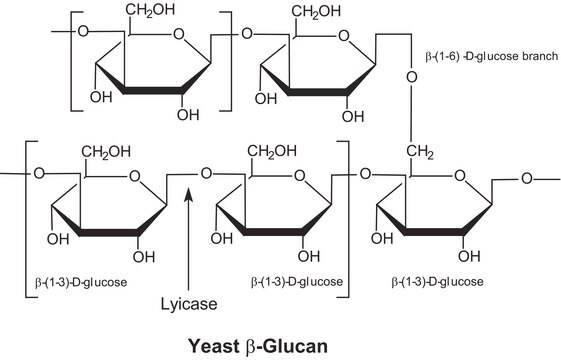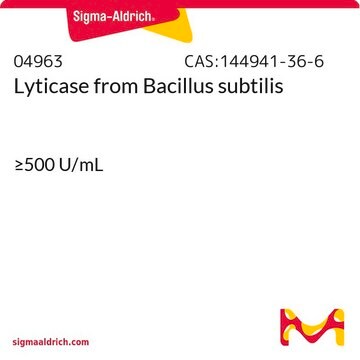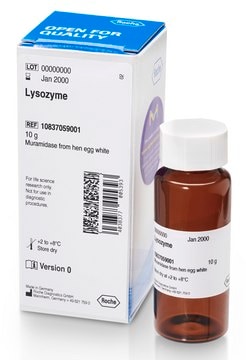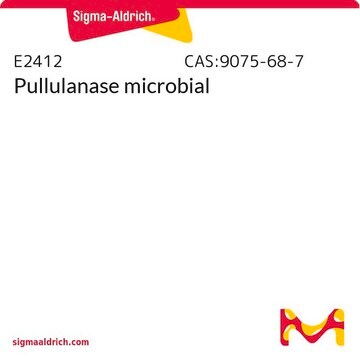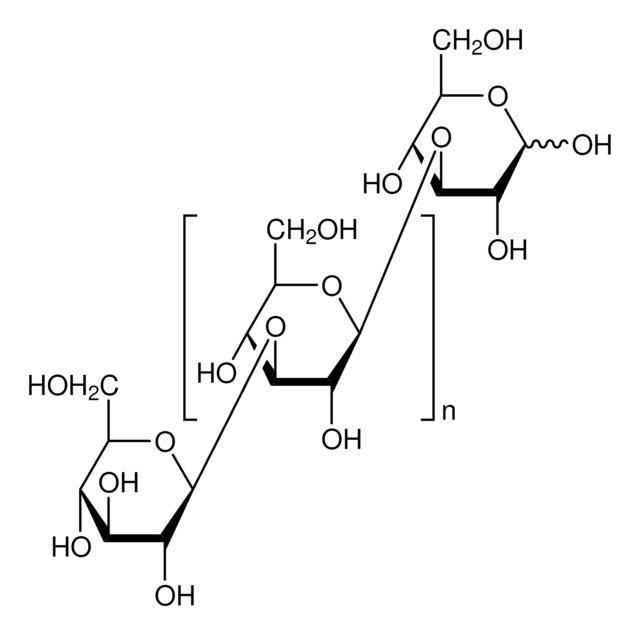추천 제품
생물학적 소스
bacterial (Arthrobacter luteus)
Quality Level
양식
lyophilized powder
특이 활성도
≥200 units/mg solid
기술
cell based assay: suitable
적합성
suitable for cell lysis
응용 분야
diagnostic assay manufacturing
저장 온도
−20°C
유사한 제품을 찾으십니까? 방문 제품 비교 안내
애플리케이션
Lyticase from Arthrobacter luteus has been used for resuspending cells to extract high-molecular weight DNA for polymerase chain reaction (PCR) fingerprint analyses.
Lyticase from Arthrobacter luteus has been used:
- as a component in spheroplasting buffer to prepare yeast nuclear extracts
- for digestion in sample preparation for β-glucan enzymatic assay using yeast
- to lyse cells for RNA isolation
생화학적/생리학적 작용
Lyticase enzyme is frequently used in fungal research, particularly for species identification using polymerase chain reaction (PCR)-based techniques. It can break down β (1→3) and β (1→4) bonds between glucose units.
Lyticase hydrolyzes poly-β(1→3)-glucose such as yeast cell wall glucan.
Lyticase is a lysing enzyme that is used to extract DNA from yeast cells by inducing partial spheroplast formation. Spheroplasts are subsequently lysed to release DNA. Lyticase is preferred to digest cell walls of yeast, which are difficult to disrupt because the cell walls may form capsules or resistant spores. Lyticase contains β-(1→;3)-glucan laminaripentaohydrolase along with β-(1→3)-glucanase, protease, and mannanase activities. It is useful with yeast cells such as e.g. Candida, Debaryomyces, Saccharomyces, Saccharomycopsis, Saccharomycodes, Eremothecium, and Schwanniomyces species.
단위 정의
One unit will produce a ΔA800 of 0.001 per min at pH 7.5 at 25 °C, using a suspension of yeast as substrate in a 3 mL reaction mixture.
기타 정보
For R&D use only. Not for drug, household, or other uses. Please consult the Safety Data Sheet for information regarding hazards and safe handling practices.
View more information on enzymes for complex carbohydrate analysis at www.sigma-aldrich.com/enzymeexplorer
신호어
Danger
유해 및 위험 성명서
예방조치 성명서
Hazard Classifications
Resp. Sens. 1
Storage Class Code
11 - Combustible Solids
WGK
WGK 3
Flash Point (°F)
Not applicable
Flash Point (°C)
Not applicable
개인 보호 장비
Eyeshields, Gloves, type N95 (US)
가장 최신 버전 중 하나를 선택하세요:
시험 성적서(COA)
Lot/Batch Number
이미 열람한 고객
Lisbeth Rosager Poulsen et al.
The Plant cell, 20(3), 658-676 (2008-03-18)
Vesicle budding in eukaryotes depends on the activity of lipid translocases (P(4)-ATPases) that have been implicated in generating lipid asymmetry between the two leaflets of the membrane and in inducing membrane curvature. We show that Aminophospholipid ATPase3 (ALA3), a member
Naturally occurring novel promoters around pyruvate branch-point for recombinant protein production in Pichia pastoris (Komagataella phaffii): pyruvate decarboxylase-and pyruvate kinase-promoters
Massahi A and Calik P
Biochemical Engineering Journal, 138, 111-120 (2018)
M Groenewald et al.
Persoonia, 21, 17-27 (2008-12-01)
The type species of the genus Debaryomyces, Debaryomyces hansenii, is a highly heterogeneous species. It has been isolated from a large diversity of natural sources including fruit, air, water, soil, but most frequently from processed food products. The species delineation
A protein transformation protocol for introducing yeast prion particles into yeast
Tanaka M, et al.
Methods in Enzymology, 470, 681-693 (2010)
E C Williamson et al.
Journal of clinical microbiology, 39(1), 47-50 (2001-01-04)
Respiratory tract colonization with Scedosporium apiospermum in patients with chronic suppurative lung disease is a significant concern for lung transplantation candidates, since Scedosporium infections occurring posttransplantation are usually untreatable. Up to 10% of patients with cystic fibrosis attending our respiratory
프로토콜
This procedure may be used for the determination of Lyticase activity using Baker’s yeast as the substrate.
관련 콘텐츠
Find protein research tools to prepare, isolate, and analyze proteins. Organized by how to extract, protect, purify, enrich, modify, and quantify proteins.
자사의 과학자팀은 생명 과학, 재료 과학, 화학 합성, 크로마토그래피, 분석 및 기타 많은 영역을 포함한 모든 과학 분야에 경험이 있습니다..
고객지원팀으로 연락바랍니다.
